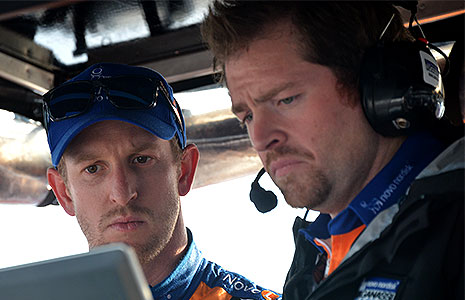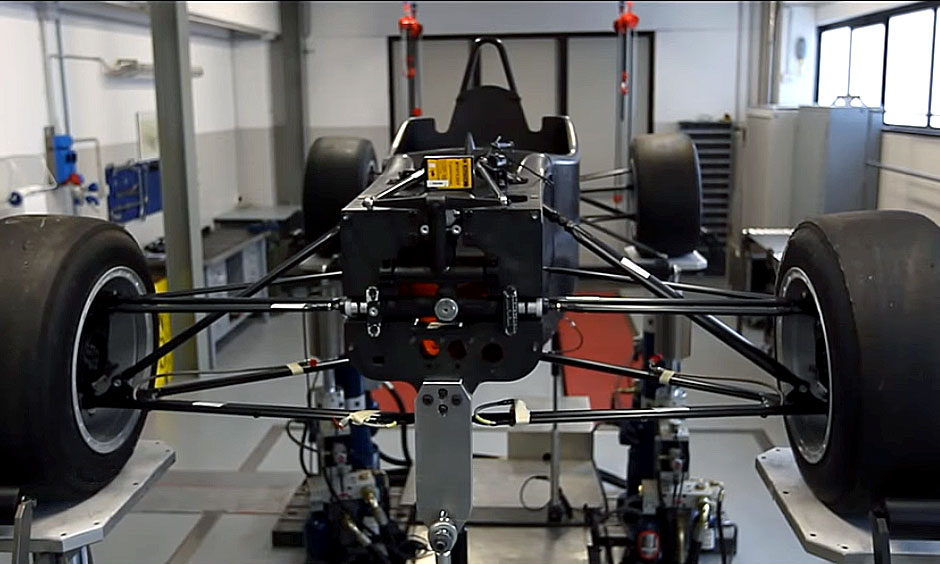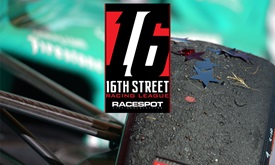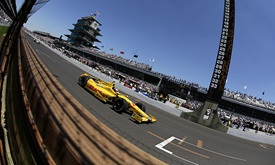INDYCAR Q&A: Shaker Rig 101
JAN 08, 2016
Every aspect of an Indy car’s performance is transferred to the ground through four remarkably small contact patches. It’s in that interaction between those Firestone tires and city streets at St. Petersburg, or Indianapolis Motor Speedway’s blend of flat surfaces and banking, where Verizon IndyCar Series teams focus their efforts to master incredible speed and efficiency.
All of the suspension, tire and aerodynamic tuning carried out by teams is done to improve the car’s ability to accelerate, corner or brake. With a limited number of track tests allowed, Verizon IndyCar Series teams use a variety of off-track engineering tools to replicate a day at Mid-Ohio Sports Car Course, Iowa Speedway or any of the other circuits on the schedule.
 One of those testing tools is known as a “shaker rig,” also called a “seven-post rig” in deference to the seven hydraulic cylinders used to manipulate the race car and simulate a lap of bouncing and shaking at a track. Chip Ganassi Racing’s Brad Goldberg, who engineered Charlie Kimball’s No. 83 Novo Nordisk Chevrolet before transferring to the team’s sports car effort, explains how a shaker rig works and its benefits.
One of those testing tools is known as a “shaker rig,” also called a “seven-post rig” in deference to the seven hydraulic cylinders used to manipulate the race car and simulate a lap of bouncing and shaking at a track. Chip Ganassi Racing’s Brad Goldberg, who engineered Charlie Kimball’s No. 83 Novo Nordisk Chevrolet before transferring to the team’s sports car effort, explains how a shaker rig works and its benefits.
Q: What does a shaker rig do and what purpose does it serve?
Goldberg: A shaker rig is meant to isolate and develop a car’s handling characteristics by using hydraulic cylinders attached to it in different locations. The cylinders move up and down to emulate various items such as banking load, aero downforce, cornering load, load transfer, etc., from a pre-programmed lap of a track. We can’t make the car move like it would on the track on its own, so the rig acts like the track going beneath the car and recreates all the bumps and forces by pushing up or down on the car.
The rig allows you to test different items while removing all the different variables a racetrack creates. For example, at a racetrack there are many changing conditions such as tire degradation, weather condition changes or track surface grip changes throughout each session. With little time during each session and not a lot of test days to go and try things in the real world, we use the shaker rig to try different suspension settings and other tuning options, to make decisions in terms of chassis development.
There are many different models of seven-post rigs throughout the world. It’s similar to several people customizing the same car. It starts out very similar, however, each owner applies different ideas and theories behind how it’s built and what criteria is important.
Q: How much does an INDYCAR-grade shaker rig cost to buy or rent/operate?
Goldberg: To build and maintain a shaker rig would cost millions of dollars. That’s why most teams rent instead of buying. INDYCAR teams rent time from a couple companies. Auto Research Center in Indianapolis has a rig, as well as Ohlins in Hendersonville, N.C.
Q: How do you prepare an Indy car for shaker rig testing and how do you attach it to the rig?
Goldberg: The car essentially is the same as it would run on the racetrack. If you were going to a shaker rig to strictly focus on street-course development, the car would be built similar to St. Pete, Long Beach, Detroit or Toronto specification. It’s not out of the question to take a car straight from a racetrack and install it on a rig to verify the performance results (following an event).
There are multiple attachments for a car to be mounted on the rig. There are cylinders under each tire, usually one at the front of the car where the nose would attach, one at the rear of the car near where the rear wing is located and two in the middle – usually at the back of the tub before the motor and attaching outboard of the underwing.
Q: How does the rig work in physical terms, how is it controlled and who controls it?
Goldberg: The cylinders move up and down to create different simulated loads going from the tire through the suspension to the chassis. For example, the front and rear cylinders pull down on the chassis, but the cylinders under the tires do not move. This creates a simulated aero downforce load. It’s controlled via computers and an engineer who is well versed in the software to control all the input parameters and outputs as well.
The cylinders are far stronger than a car. If one item is set slightly wrong, it could very quickly break the car, hence by every shaker rig is always a big red “STOP” button.
Q: What information are you looking for from a run or multiple runs on the shaker rig?
Goldberg: It really depends on what the test plan calls for. Sometimes you go to a shaker just to prove theories on dampers into the next year. Other times you might be searching for roll support, better compliance over curbs or better load transfer. Sometimes you are going to prove results or ideas developed from a racetrack. Generally, you keep an eye on a set few items such as roll support and ride height variation throughout the simulated lap.
Q: Is there a standard length of time the rig will be activated to shake the car?
Goldberg: Not really. Sometimes you run through many tests at once. With others, it might simply be a quick lap around Iowa.
Q: How do you input the track model for the rig to replicate? Where does that data come from and how accurate is it?
Goldberg: Most rigs have the capability to be driven by data directly from a racetrack. For example, an Indy car has sensors to measure the forces being put through the suspension — the loading. The force can be input into a rig as well as damper travel, G-force accelerations (lateral, vertical and longitudinal) and aero forces, to create a simulated (but highly accurate) lap of a racetrack. Think of it in terms of reverse engineering a lap around a circuit.
The data caused by the racetrack is now causing the shaker to emulate the same movement. It’s imperative to ensure the data you acquire at a racetrack is highly accurate, especially if the shaker rig program is going to use the data for the simulated laps.
Q: How is the data from a shaker rig run captured and reviewed?
Goldberg: Most of the shaker companies have their own data analysis software, but teams also interpret the data on their own by exporting it and reviewing it through their own software.
Q: Once a run is done and you've reviewed the information, what are the next steps?
Goldberg: When starting a shaker rig test, a team will have set goals and a test list to run through, so once the rig is set up, the runs are very quick. Then the data for each run is analyzed and new items are created to test based off the results of the original test list. It continues going in that test cycle as you learn something and try something new from what you learned.
Q: How many different tuning options will you try (or prepare) for runs on the shaker rig?
Goldberg: Lots. I am convinced it’s possible to spend months at a shaker rig and still be learning at the end!
Q: How many runs will you complete during an average test?
Goldberg: As many as time permits. The most cost-effective way of using the shaker rig is to have minimal downtime.
Q: How much of what you learn during shaker rig testing comes from blind exploration or surprises, and how much is done to prove or disprove a result you expect?
Goldberg: As an engineer, we would always like to say nothing surprises us, however it does happen quite often. Sometimes a suspension setting will be off by accident and the result shows really favorable results, which leads to an all-new path of exploration. This is when it becomes quite fun!
Q: How closely can you match the results of what you learn on the rig with on-track performance?
Goldberg: With a set list of goals and tests, it is entirely possible to take something from the rig and correlate very precisely to the racetrack.
Q: How much preparation goes into the average shaker rig test?
Goldberg: It usually takes a day or two to prepare the car for the rig. However, to design and create all the brackets, sensors and mounts, it can take months.
Q: How much does the shaker rig testing you’ve completed before a race improve a team's efficiency and performance once practice starts for an event?
Goldberg: It can allow the chassis to be closer to the final race or qualifying setup much sooner than if we had to test and try a ton of things during the (on-track) session. Instead of having to worry about dampers or springs, it can give you an idea of what each item is doing and what area may need explored during a race weekend. Using the shaker rig lets us try a bunch of things before we get to the race, remove the ones that didn’t work and start with the ones that did.
Q: Any fun shaker rig stories to share?
Goldberg: Shaker testing can be very repetition-based and a feeling of doing the same thing over and over. We were at the final day of a multiple-day test and the car needed to be loaded and taken back once we were done. The truck driver had a bit of a drive ahead of him and came in later in the afternoon so he could rest up for the drive home.
We were all pretty worn out from staring at our computer screens and a bouncing race car at that point, and he showed up with a bundle of milkshakes from a local ice cream place! It brought the entire room’s spirits up and smiles to all of our faces. Sometimes it’s the little things that can make a big difference. However, he has now ruined the expectation for all the future truck drivers with milkshakes at the shaker rig!



















